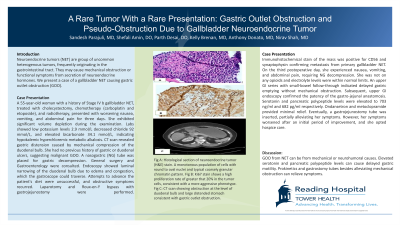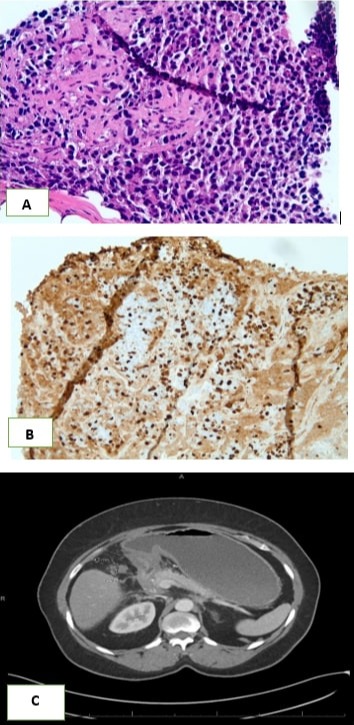Sunday Poster Session
Category: Stomach
P1417 - A Rare Tumor With a Rare Presentation: Gastric Outlet Obstruction and Pseudo-Obstruction Due to Gallbladder Neuroendocrine Tumor
Sunday, October 22, 2023
3:30 PM - 7:00 PM PT
Location: Exhibit Hall

Has Audio
- SP
Sandesh Parajuli, MD
Reading Hospital
Reading, PA
Presenting Author(s)
Sandesh Parajuli, MD, Shefali Amin, DO, MSEd, Parth Desai, DO, Anthony Donato, MD, Kelly Brenan, MD, Nirav Shah, MD
Reading Hospital, Reading, PA
Introduction: Neuroendocrine tumors (NET) are group of uncommon heterogenous tumors, frequently originating in the gastrointestinal tract. They may cause mechanical obstruction or functional symptoms from secretion of neuroendocrine hormones. We present a case of a gallbladder NET causing gastric outlet obstruction (GOO).
Case Description/Methods: A 55-year-old woman with a history of Stage IV b gallbladder NET, treated with cholecystectomy, chemotherapy (carboplatin and etoposide), and radiotherapy, presented with worsening nausea, vomiting, and abdominal pain for three days. She exhibited significant volume depletion during the examination. Labs showed low potassium levels 2.9 mmol/L decreased chloride 92 mmol/L, and elevated bicarbonate 34.1 mmol/L, indicating hypokalemic hyperchloremic metabolic alkalosis. CT scan revealed gastric distension caused by mechanical compression of the duodenal bulb. She had no previous history of gastric or duodenal ulcers, suggesting malignant GOO. A nasogastric (NG) tube was placed for gastric decompression. General surgery and Gastroenterology were consulted. Endoscopy showed luminal narrowing of the duodenal bulb due to edema and congestion, which the gastroscope could traverse. Attempts to advance the patient's diet were unsuccessful, and obstructive symptoms recurred. Laparotomy and Roux-en-Y bypass with gastrojejunostomy were performed.
Immunohistochemical stain of the mass was positive for CD56 and synaptophysin confirming metastasis from primary gallbladder NET. On the third postoperative day, she experienced nausea, vomiting, and abdominal pain, requiring NG decompression. She was not on any opioids and electrolyte levels were within normal limits. An upper GI series with small-bowel follow-through indicated delayed gastric emptying without mechanical obstruction. Subsequent, upper GI endoscopy confirmed the patency of the gastro-jejunal anastomosis. Serotonin and pancreatic polypeptide levels were elevated to 703 ng/ml and 682 pg/ml respectively. Ondansetron and metoclopramide provided minimal relief. Eventually, a gastrojejunostomy tube was inserted, partially alleviating her symptoms. However, her symptoms worsened after an initial period of improvement, and she opted hospice care.
Discussion: GOO from NET can be from mechanical or neurohumoral causes. Elevated serotonin and pancreatic polypeptide levels can cause delayed gastric motility. Prokinetics and gastrostomy tubes besides alleviating mechanical obstruction can relieve symptoms.

Disclosures:
Sandesh Parajuli, MD, Shefali Amin, DO, MSEd, Parth Desai, DO, Anthony Donato, MD, Kelly Brenan, MD, Nirav Shah, MD. P1417 - A Rare Tumor With a Rare Presentation: Gastric Outlet Obstruction and Pseudo-Obstruction Due to Gallbladder Neuroendocrine Tumor, ACG 2023 Annual Scientific Meeting Abstracts. Vancouver, BC, Canada: American College of Gastroenterology.
Reading Hospital, Reading, PA
Introduction: Neuroendocrine tumors (NET) are group of uncommon heterogenous tumors, frequently originating in the gastrointestinal tract. They may cause mechanical obstruction or functional symptoms from secretion of neuroendocrine hormones. We present a case of a gallbladder NET causing gastric outlet obstruction (GOO).
Case Description/Methods: A 55-year-old woman with a history of Stage IV b gallbladder NET, treated with cholecystectomy, chemotherapy (carboplatin and etoposide), and radiotherapy, presented with worsening nausea, vomiting, and abdominal pain for three days. She exhibited significant volume depletion during the examination. Labs showed low potassium levels 2.9 mmol/L decreased chloride 92 mmol/L, and elevated bicarbonate 34.1 mmol/L, indicating hypokalemic hyperchloremic metabolic alkalosis. CT scan revealed gastric distension caused by mechanical compression of the duodenal bulb. She had no previous history of gastric or duodenal ulcers, suggesting malignant GOO. A nasogastric (NG) tube was placed for gastric decompression. General surgery and Gastroenterology were consulted. Endoscopy showed luminal narrowing of the duodenal bulb due to edema and congestion, which the gastroscope could traverse. Attempts to advance the patient's diet were unsuccessful, and obstructive symptoms recurred. Laparotomy and Roux-en-Y bypass with gastrojejunostomy were performed.
Immunohistochemical stain of the mass was positive for CD56 and synaptophysin confirming metastasis from primary gallbladder NET. On the third postoperative day, she experienced nausea, vomiting, and abdominal pain, requiring NG decompression. She was not on any opioids and electrolyte levels were within normal limits. An upper GI series with small-bowel follow-through indicated delayed gastric emptying without mechanical obstruction. Subsequent, upper GI endoscopy confirmed the patency of the gastro-jejunal anastomosis. Serotonin and pancreatic polypeptide levels were elevated to 703 ng/ml and 682 pg/ml respectively. Ondansetron and metoclopramide provided minimal relief. Eventually, a gastrojejunostomy tube was inserted, partially alleviating her symptoms. However, her symptoms worsened after an initial period of improvement, and she opted hospice care.
Discussion: GOO from NET can be from mechanical or neurohumoral causes. Elevated serotonin and pancreatic polypeptide levels can cause delayed gastric motility. Prokinetics and gastrostomy tubes besides alleviating mechanical obstruction can relieve symptoms.

Figure: Fig A: Histological section of neuroendocrine tumor (H&E) stain. A monotonous population of cells with round to oval nuclei and typical coarsely granular chromatin pattern.
Fig B: Ki67 stain shows a high proliferation rate of greater that 20% in the tumor cells, consistent with a more aggressive phenotype.
Fig C: CT scan showing obstruction at the level of duodenal bulb and large distended stomach consistent with gastric outlet obstruction.
Fig B: Ki67 stain shows a high proliferation rate of greater that 20% in the tumor cells, consistent with a more aggressive phenotype.
Fig C: CT scan showing obstruction at the level of duodenal bulb and large distended stomach consistent with gastric outlet obstruction.
Disclosures:
Sandesh Parajuli indicated no relevant financial relationships.
Shefali Amin indicated no relevant financial relationships.
Parth Desai indicated no relevant financial relationships.
Anthony Donato indicated no relevant financial relationships.
Kelly Brenan indicated no relevant financial relationships.
Nirav Shah indicated no relevant financial relationships.
Sandesh Parajuli, MD, Shefali Amin, DO, MSEd, Parth Desai, DO, Anthony Donato, MD, Kelly Brenan, MD, Nirav Shah, MD. P1417 - A Rare Tumor With a Rare Presentation: Gastric Outlet Obstruction and Pseudo-Obstruction Due to Gallbladder Neuroendocrine Tumor, ACG 2023 Annual Scientific Meeting Abstracts. Vancouver, BC, Canada: American College of Gastroenterology.
